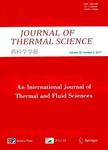Effect of wastewater treatment processes on the pyrolysis properties of the pyrolysis tars from sewage sludges
Effect of wastewater treatment processes on the pyrolysis properties of the pyrolysis tars from sewage sludges作者机构:School of Environment & Chemical Engineering Tianjin Polytechnic University Tianjin 300160 China Department of Environmental and Municipal Engineering Tianjin Institute of Urban Construction Tianjin 300384China
出 版 物:《Journal of Thermal Science》 (热科学学报(英文版))
年 卷 期:2011年第20卷第2期
页 面:167-172页
核心收录:
学科分类:083002[工学-环境工程] 0830[工学-环境科学与工程(可授工学、理学、农学学位)] 081702[工学-化学工艺] 08[工学] 0817[工学-化学工程与技术]
基 金:supported by the project of Tianjin higher education under contract (20060522) the project of Tianjin Polytechnic University (2230004)
主 题:sewage sludge pyrolysis tar pyrolysis wastewater treatment process anaerobic digestion
摘 要:The pyrolysis properties of five different pyrolysis tars, which the tars from 1# to 5# are obtained by pyrolyzing the sewage sludges of anaerobic digestion and indigestion from the A2/O wastewater treatment process, those from the activated sludge process and the indigested sludge from the continuous SBR process respectively, were studied by thermal gravimetric analysis at a heating rate of 10 ℃/min in the nitrogen atmosphere. The results show that the pyrolysis processes of the pyrolysis tars of 1#, 2#, 3# and 5# all can be divided into four stages: the stages of light organic compounds releasing, heavy polar organic compounds decomposition, heavy organic compounds decomposition and the residual organic compounds decomposition. However, the process of 4# pyrolysis tar is only divided into three stages: the stages of light organic compounds releasing, decomposition of heavy polar organic compounds and the residual heavy organic compounds respectively. Both the sludge anaerobic digestion and the anaerobic process in wastewater treatment processes make the content of light organic compounds in tars decrease, but make that of heavy organic compounds with complex structure increase. Besides, both make the pyrolysis properties of the tars become worse. The pyrolysis reaction mechanisms of the five pyrolysis tars have been studied with Coats-Redfern equation. It shows that there are the same mechanism functions in the first stage for the five tars and in the second and third stage for the tars of 1#, 2#, 3# and 5#, which is different with the function in the second stage for 4# tar. The five tars are easy to volatile.



